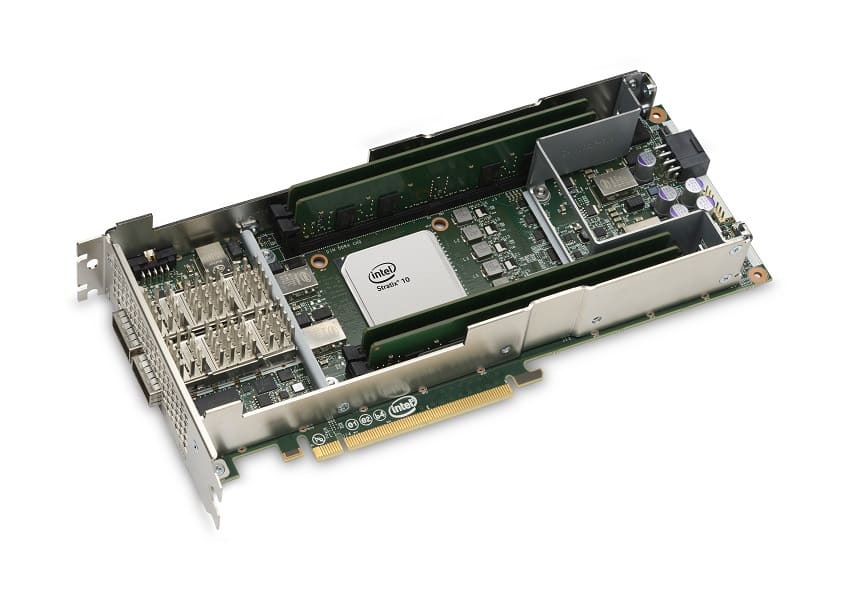 Intel recently extended its field programmable gate array (FPGA) acceleration platform portfolio with the addition of the new Intel Programmable Acceleration Card (PAC) with Intel Stratix 10 SX FPGA. The Stratix 10 SX is manufactured on Intel's 14nm process and leverages the Acceleration Stack for Intel Xeon CPU with FPGAs, providing data center developers a robust platform to deploy FPGA-based accelerated workloads. Hewlett Packard Enterprise will be the first OEM to incorporate the Intel PAC with Stratix 10 SX FPGA along with the Intel Acceleration Stack for Intel Xeon Scalable processor with FPGAs into its server offering.
Intel recently extended its field programmable gate array (FPGA) acceleration platform portfolio with the addition of the new Intel Programmable Acceleration Card (PAC) with Intel Stratix 10 SX FPGA. The Stratix 10 SX is manufactured on Intel's 14nm process and leverages the Acceleration Stack for Intel Xeon CPU with FPGAs, providing data center developers a robust platform to deploy FPGA-based accelerated workloads. Hewlett Packard Enterprise will be the first OEM to incorporate the Intel PAC with Stratix 10 SX FPGA along with the Intel Acceleration Stack for Intel Xeon Scalable processor with FPGAs into its server offering.
Intel recently extended its field programmable gate array (FPGA) acceleration platform portfolio with the addition of the new Intel Programmable Acceleration Card (PAC) with Intel Stratix 10 SX FPGA. The Stratix 10 SX is manufactured on Intel's 14nm process and leverages the Acceleration Stack for Intel Xeon CPU with FPGAs, providing data center developers a robust platform to deploy FPGA-based accelerated workloads. Hewlett Packard Enterprise will be the first OEM to incorporate the Intel PAC with Stratix 10 SX FPGA along with the Intel Acceleration Stack for Intel Xeon Scalable processor with FPGAs into its server offering.

Field Programmable Gate Arrays (FPGAs) on programmable cards allow vendors to create their own reconfigurable digital circuits; as opposed to standard expansion cards which have a fixed function. An FPGA has an undefined function when it is manufactured and thus must be reconfigured before it can be used in a circuit. The price has been driven down in recent years, moving the affordability from just the larger enterprise down to nearly all organizations, allowing even smaller businesses to leverage the technology. We covered some of Intel's advancements in this area earlier this year. The 10 SX builds on those advancements.
The Stratix is similar to Intel's earlier Arria FPGA, but with a few key differences. The Stratix is a larger form factor card built for inline processing and memory-intensive workloads, like streaming analytics and video transcoding. While the smaller form factor Intel PAC with Arria 10 FPGA is ideal for backtesting, database acceleration, and image processing workloads. Happily, the Intel and Stratix are code compatible so companies can begin development on the Arria immediately and switch over when mass production starts.
Intel plans to offer the Intel Programmable Acceleration Card (PAC) with Intel Stratix 10 SX FPGA alongside several tools to program it. The solution will include a Production-grade FPGA Interface Manager (FIM) to which Intel and partner AFUs are connected. As well as an Acceleration Stack for Intel Xeon CPU with FPGAs, including a common set of APIs and open-source drivers that work seamlessly with industry-leading OS, virtualization and orchestration software across the portfolio of Intel programmable acceleration cards. Not to mention Support for native, network-attached workloads; initial partners including Adaptive Microware and Megh Computing, with more to come.
Availability
Production programmable acceleration cards available through select original equipment manufacturers (OEMs) in 1H19 (HPE is the only listed partner at the time of print). Intel also offers a link on their site to order engineering samples.
Sign up for the StorageReview newsletter
